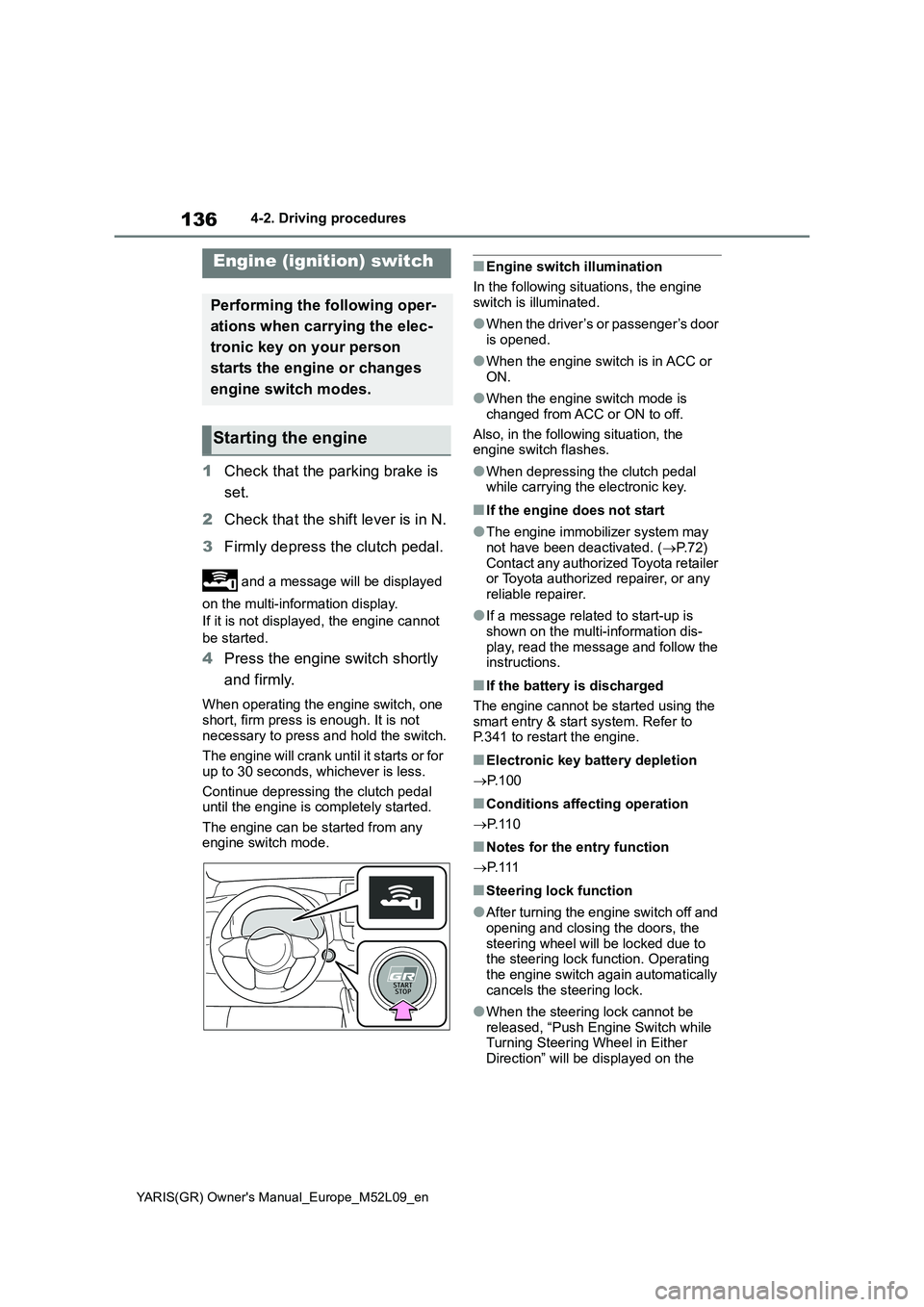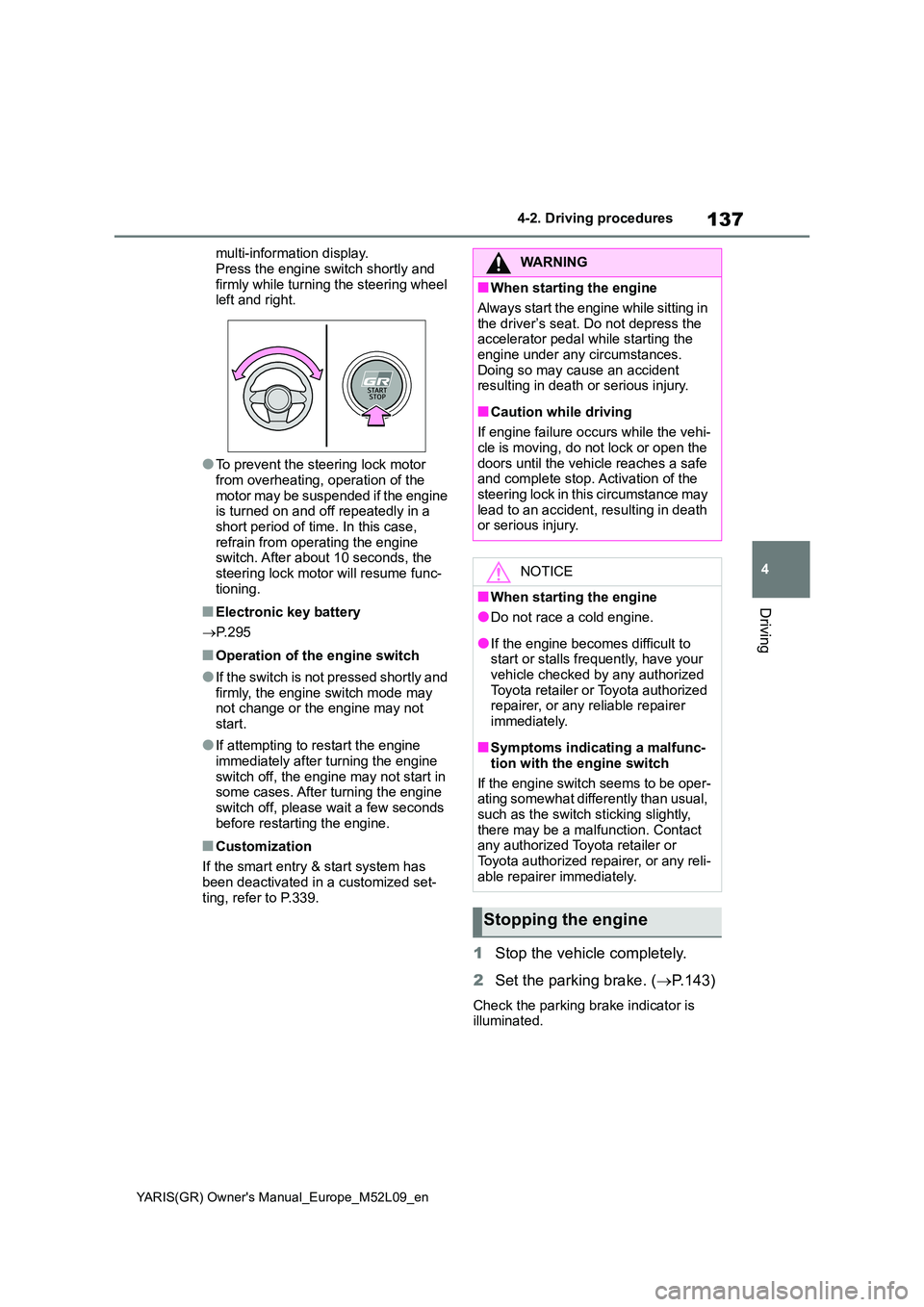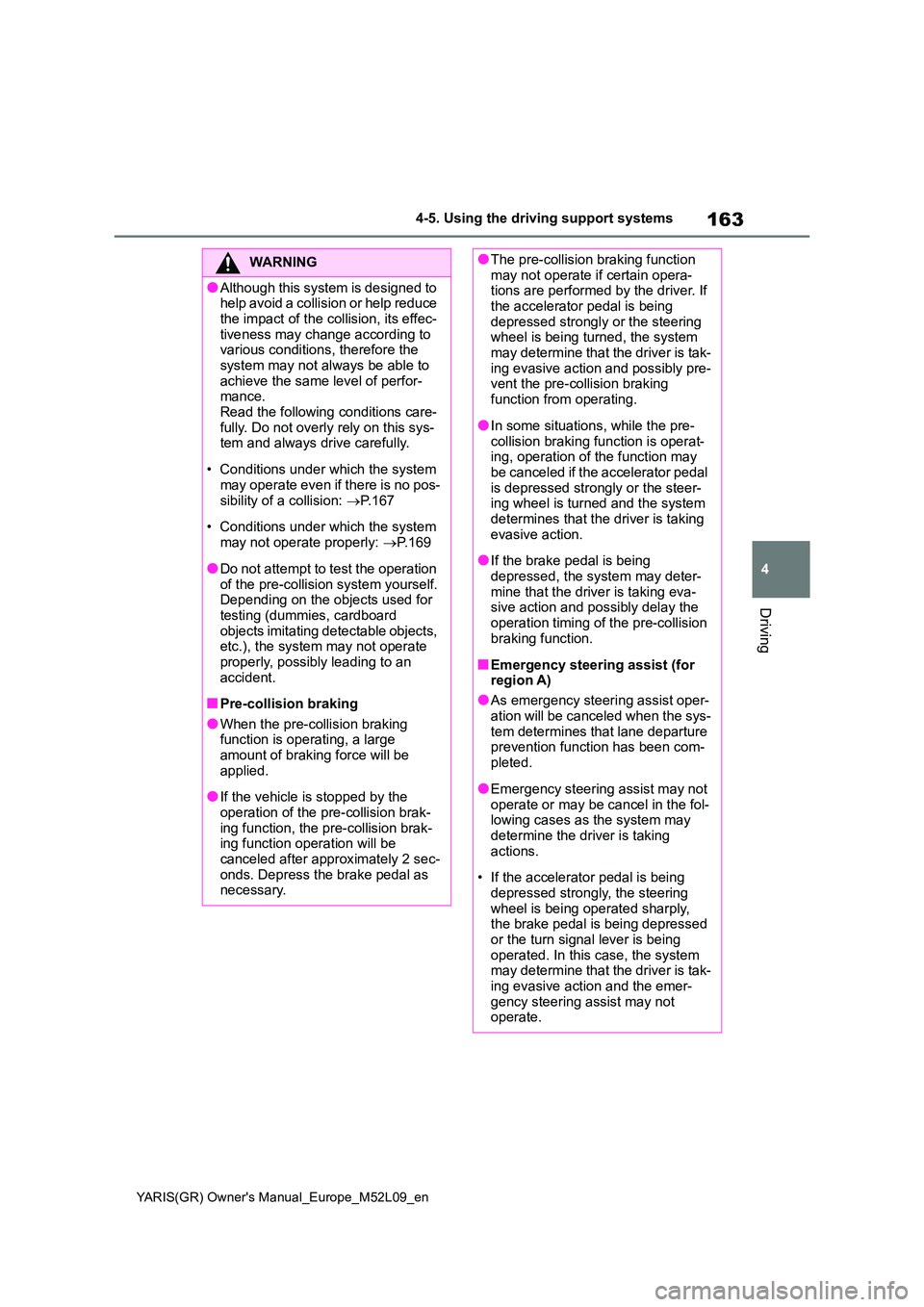2021 TOYOTA GR YARIS steering wheel
[x] Cancel search: steering wheelPage 125 of 458

123
3
YARIS(GR) Owner's Manual_Europe_M52L09_en
3-4. Adjusting the steering wheel and mirrors
Before driving
1Folds the mirrors
2 Extends the mirrors
Putting the outside rear view mirror
folding switch in the neutral position
sets the mirrors to automatic mode.
Automatic mode allows the folding or
extending of the mirrors to be linked to
locking/unlocking of the doors with the
smart entry function or wireless remote
control.
■Using automatic mode in cold
weather
When automatic mode is used in cold weather, the door mirror could freeze up
and automatic stowing and return may not be possible. In this case, remove any ice and snow from the door mirror,
then either operate the mirror using manual mode or move the mirror by hand.
■Customization
Some functions can be customized. ( →P.361)
Folding and extending the
mirrors
WARNING
■When a mirror is moving
To avoid personal injury and mirror malfunction, be careful not to get your hand caught by the moving mirror.
Page 130 of 458

128
YARIS(GR) Owner's Manual_Europe_M52L09_en
4-1. Before driving
4- 1. B ef ore dr iv in g
■Starting the engine
→P. 1 3 6
■Driving
1While depressing the clutch
pedal, shift the shift lever to 1.
(→P.139)
2Release the parking brake.
(→P.143)
3Gradually release the clutch
pedal. At the same time, gently
depress the accelerator pedal to
accelerate the vehicle.
■Stopping
1While depressing the clutch
pedal, depress the brake pedal.
2If necessary, set the parking
brake.
If the vehicle is to be stopped for an
extended period of time, shift the shift
lever to N. (→P.139)
If the Stop & Start system is enabled,
shifting the shift lever to N and releas-
ing the clutch pedal will stop the engine.
(→P.196)
■Parking the vehicle
1While depressing the clutch
pedal, depress the brake pedal.
2Set the parking brake. (→P.143)
Check that the parking brake indicator is illuminated.
3Shift the shift lever to N.
(→P.139)
If parking on a hill, shift the shift lever to
1 or R and block the wheels as needed.
4Turn the engine switch to OFF
to stop the engine.
5Slowly release the brake pedal.
6Lock the door, making sure that
you have the key on your per-
son.
■Starting off on a steep uphill
1Make sure that the parking
brake is set and shift the shift
lever to 1.
2Lightly depress the accelerator
pedal at the same time as grad-
ually releasing the clutch pedal.
3Release the parking brake.
■Driving in the rain
●Drive carefully when it is raining,
because visibility will be reduced, the
windows may become fogged-up, and
the road will be slippery.
●Drive carefully when it starts to rain,
because the road surface will be
especially slippery.
●Refrain from high speeds when driv-
ing on an expressway in the rain,
because there may be a layer of water
between the tires and the road sur-
face, preventing the steering and
brakes from operating properly.
■Restraining the engine output
(Brake Override System)
●When the accelerator and brake ped-
als are depressed at the same time,
the engine output may be restrained.
●A warning message is displayed on
the multi-information display and
Driving the vehicle
The following procedures
should be observed to ensure
safe driving:
Driving procedure
Page 132 of 458

130
YARIS(GR) Owner's Manual_Europe_M52L09_en
4-1. Before driving
WARNING
●Do not drive the vehicle over or stop the vehicle near flammable
materials. The exhaust system and exhaust gases can be extremely hot. These
hot parts may cause a fire if there is any flammable material nearby.
●During normal driving, do not turn off the engine. Turning the engine off while driving will not cause loss
of steering or braking control, but the power assist to these systems will be lost. This will make it more
difficult to steer and brake, so you should pull over and stop the vehi-cle as soon as it is safe to do so.
However, in the event of an emer- gency, such as if it becomes impos-sible to stop the vehicle in the
normal way: →P. 3 0 6
●Use engine braking (downshift) to
maintain a safe speed when driving down a steep hill.Using the brakes continuously may
cause the brakes to overheat and lose effectiveness. ( →P.139)
●Do not adjust the positions of the steering wheel, the seat, or the inside or outside rear view mirrors
while driving. Doing so may result in a loss of vehicle control.
●Always check that all passengers’ arms, heads or other parts of their
body are not outside the vehicle.
●Do not drive the vehicle off-road.
This is not an AWD vehicle designed for off-road driving. Pro-ceed with all due caution if it
becomes unavoidable to drive off- road.
●Do not drive across a river or through other bodies of water.This may cause electric/electronic
components to short circuit, dam- age the engine or cause other seri-ous damage to the vehicle.
■When driving on slippery road surfaces
●Sudden braking, acceleration and steering may cause tire slippage and reduce your ability to control
the vehicle.
●Sudden acceleration, engine brak-
ing due to shifting, or changes in engine speed could cause the vehi-cle to skid.
●After driving through a puddle, lightly depress the brake pedal to
make sure that the brakes are func- tioning properly. Wet brake pads may prevent the brakes from func-
tioning properly. If the brakes on only one side are wet and not func-tioning properly, steering control
may be affected.
■When shifting the shift lever
●Do not shift the shift lever to R while the vehicle is moving forward.Doing so can damage the transmis-
sion and may result in a loss of vehicle control.
●Do not shift the shift lever to a driv-ing position while the vehicle is moving backward.
Doing so can damage the transmis- sion and may result in a loss of vehicle control.
●Moving the shift lever to N while the vehicle is moving will disengage the
engine from the transmission. Engine braking is not available when N is selected.
Page 135 of 458

133
4
YARIS(GR) Owner's Manual_Europe_M52L09_en
4-1. Before driving
Driving
NOTICE
• Do not use the clutch pedal to adjust vehicle speed. When stop-
ping the vehicle with the shift lever in a position other then N, make sure to fully depress the clutch
pedal and stop the vehicle using the brake.Doing so may damage the clutch.
• When stopping the vehicle with the shift lever in a position other than N,
make sure to fully depress the clutch pedal and stop the vehicle using the brakes.
●Do not shift the shift lever to R with-out the vehicle completely stopped.
Doing so may damage the clutch, transmission and gears.
■Avoiding damage to vehicle parts
●Do not turn the steering wheel fully in either direction and hold it there
for an extended period of time. Doing so may damage the power steering motor.
●When driving over bumps in the road, drive as slowly as possible to
avoid damaging the wheels, under- side of the vehicle, etc.
●Make sure to idle the engine imme-diately after high-load driving. Stop the engine only after the turbo-
charger has cooled down. Failure to do so may cause damage to the turbocharger.
■If you get a flat tire while driving
A flat or damaged tire may cause the
following situations. Hold the steering wheel firmly and gradually depress the brake pedal to slow down the
vehicle.
●It may be difficult to control your vehicle.
●The vehicle will make abnormal sounds or vibrations.
●The vehicle will lean abnormally.
Information on what to do in case of a
flat tire ( →P.325)
■When encountering flooded
roads
Do not drive on a road that has flooded after heavy rain, etc. Doing so
may cause the following serious dam- age to the vehicle:
●Engine stalling
●Short in electrical components
●Engine damage caused by water immersion
In the event that you drive on a flooded road and the vehicle becomes flooded or stuck in mud or
sand, be sure to have any authorized Toyota retailer or Toyota authorized repairer, or any reliable repairer check
the following:
●Brake function
●Changes in quantity and quality of oil and fluid used for the engine,
transmission, transfer, differential, etc.
●Lubricant condition for the propel-ler shaft, bearings and suspension joints (where possible), and the
function of all joints, bearings, etc.
Page 138 of 458

136
YARIS(GR) Owner's Manual_Europe_M52L09_en
4-2. Driving procedures
4-2.Driving pro cedu res
1Check that the parking brake is
set.
2Check that the shift lever is in N.
3Firmly depress the clutch pedal.
and a message will be displayed
on the multi-information display.
If it is not displayed, the engine cannot
be started.
4Press the engine switch shortly
and firmly.
When operating the engine switch, one
short, firm press is enough. It is not
necessary to press and hold the switch.
The engine will crank until it starts or for
up to 30 seconds, whichever is less.
Continue depressing the clutch pedal
until the engine is completely started.
The engine can be started from any
engine switch mode.
■Engine switch illumination
In the following situations, the engine
switch is illuminated.
●When the driver’s or passenger’s door
is opened.
●When the engine switch is in ACC or
ON.
●When the engine switch mode is
changed from ACC or ON to off.
Also, in the following situation, the
engine switch flashes.
●When depressing the clutch pedal
while carrying the electronic key.
■If the engine does not start
●The engine immobilizer system may
not have been deactivated. (→P. 7 2 )
Contact any authorized Toyota retailer
or Toyota authorized repairer, or any
reliable repairer.
●If a message related to start-up is
shown on the multi-information dis-
play, read the message and follow the
instructions.
■If the battery is discharged
The engine cannot be started using the
smart entry & start system. Refer to
P.341 to restart the engine.
■Electronic key battery depletion
→P. 1 0 0
■Conditions affecting operation
→P. 1 1 0
■Notes for the entry function
→P. 1 1 1
■Steering lock function
●After turning the engine switch off and
opening and closing the doors, the
steering wheel will be locked due to
the steering lock function. Operating
the engine switch again automatically
cancels the steering lock.
●When the steering lock cannot be
released, “Push Engine Switch while
Turning Steering Wheel in Either
Direction” will be displayed on the
Engine (ignition) switch
Performing the following oper-
ations when carrying the elec-
tronic key on your person
starts the engine or changes
engine switch modes.
Starting the engine
Page 139 of 458

137
4
YARIS(GR) Owner's Manual_Europe_M52L09_en
4-2. Driving procedures
Driving
multi-information display.
Press the engine switch shortly and firmly while turning the steering wheel left and right.
●To prevent the steering lock motor from overheating, operation of the
motor may be suspended if the engine is turned on and off repeatedly in a short period of time. In this case,
refrain from operating the engine switch. After about 10 seconds, the steering lock motor will resume func-
tioning.
■Electronic key battery
→ P. 2 9 5
■Operation of the engine switch
●If the switch is not pressed shortly and firmly, the engine switch mode may not change or the engine may not
start.
●If attempting to restart the engine
immediately after turning the engine switch off, the engine may not start in some cases. After turning the engine
switch off, please wait a few seconds before restarting the engine.
■Customization
If the smart entry & start system has
been deactivated in a customized set- ting, refer to P.339.
1 Stop the vehicle completely.
2 Set the parking brake. (→P.143)
Check the parking brake indicator is illuminated.
WARNING
■When starting the engine
Always start the engine while sitting in
the driver’s seat. Do not depress the accelerator pedal while starting the engine under any circumstances.
Doing so may cause an accident resulting in death or serious injury.
■Caution while driving
If engine failure occurs while the vehi- cle is moving, do not lock or open the
doors until the vehicle reaches a safe and complete stop. Activation of the steering lock in this circumstance may
lead to an accident, resulting in death or serious injury.
NOTICE
■When starting the engine
●Do not race a cold engine.
●If the engine becomes difficult to start or stalls frequently, have your vehicle checked by any authorized
Toyota retailer or Toyota authorized repairer, or any reliable repairer
immediately.
■Symptoms indicating a malfunc-
tion with the engine switch
If the engine switch seems to be oper- ating somewhat differently than usual,
such as the switch sticking slightly, there may be a malfunction. Contact any authorized Toyota retailer or
Toyota authorized repairer, or any reli- able repairer immediately.
Stopping the engine
Page 165 of 458

163
4
YARIS(GR) Owner's Manual_Europe_M52L09_en
4-5. Using the driving support systems
Driving
WARNING
●Although this system is designed to help avoid a collision or help reduce
the impact of the collision, its effec- tiveness may change according to various conditions, therefore the
system may not always be able to achieve the same level of perfor-mance.
Read the following conditions care- fully. Do not overly rely on this sys-tem and always drive carefully.
• Conditions under which the system may operate even if there is no pos-
sibility of a collision: →P. 1 6 7
• Conditions under which the system
may not operate properly: →P. 1 6 9
●Do not attempt to test the operation
of the pre-collision system yourself. Depending on the objects used for testing (dummies, cardboard
objects imitating detectable objects, etc.), the system may not operate properly, possibly leading to an
accident.
■Pre-collision braking
●When the pre-collision braking function is operating, a large amount of braking force will be
applied.
●If the vehicle is stopped by the
operation of the pre-collision brak- ing function, the pre-collision brak-ing function operation will be
canceled after approximately 2 sec- onds. Depress the brake pedal as necessary.
●The pre-collision braking function may not operate if certain opera-tions are performed by the driver. If
the accelerator pedal is being depressed strongly or the steering wheel is being turned, the system
may determine that the driver is tak- ing evasive action and possibly pre-vent the pre-collision braking
function from operating.
●In some situations, while the pre-
collision braking function is operat- ing, operation of the function may be canceled if the accelerator pedal
is depressed strongly or the steer- ing wheel is turned and the system determines that the driver is taking
evasive action.
●If the brake pedal is being
depressed, the system may deter- mine that the driver is taking eva-sive action and possibly delay the
operation timing of the pre-collision braking function.
■Emergency steering assist (for region A)
●As emergency steering assist oper-
ation will be canceled when the sys- tem determines that lane departure prevention function has been com-
pleted.
●Emergency steering assist may not
operate or may be cancel in the fol- lowing cases as the system may determine the driver is taking
actions.
• If the accelerator pedal is being
depressed strongly, the steering wheel is being operated sharply, the brake pedal is being depressed
or the turn signal lever is being operated. In this case, the system may determine that the driver is tak-
ing evasive action and the emer- gency steering assist may not operate.
Page 166 of 458

164
YARIS(GR) Owner's Manual_Europe_M52L09_en
4-5. Using the driving support systems
■Enabling/disabling the pre-col-
lision system
The pre-collision system can be
enabled/disabled on ( →P.361)
of the multi-information display.
The system is automatically enabled
each time the engine switch is turned to
ON.
If the system is disabled, the PCS
warning light will turn on and a
message will be displayed on the
multi-information display.
WARNING
• In some situations, while the emer- gency steering assist is operating,
operation of the function may be canceled if the accelerator pedal is depressed strongly, the steering
wheel is operated sharply or the brake pedal is being depressed and the system determines that the
driver is taking evasive action.
• When the emergency steering
assist is operating, if the steering wheel is held firmly or is operated in the opposite direction to that which
the system is generating torque, the function may be canceled.
■When to disable the pre-colli-sion system
In the following situations, disable the
system, as it may not operate prop- erly, possibly leading to an accident resulting in death or serious injury:
●When the vehicle is being towed
●When your vehicle is towing another vehicle
●When transporting the vehicle via truck, boat, train or similar means of transportation
●When the vehicle is raised on a lift with the engine running and the
tires are allowed to rotate freely
●When inspecting the vehicle using
a drum tester such as a chassis dynamometer or speedometer tes-ter, or when using an on vehicle
wheel balancer
●When a strong impact is applied to
the front bumper or front grille, due to an accident or other reasons
●If the vehicle cannot be driven in a stable manner, such as when the vehicle has been in an accident or
is malfunctioning
●When the vehicle is driven in a sporty manner or off-road
●When the tires are not properly inflated
●When the tires are very worn
●When tires of a size other than
specified are installed
●When tire chains are installed
●When a compact spare tire or an emergency tire puncture repair kit is
used
●If equipment (snow plow, etc.) that
may obstruct the radar sensor or front camera is temporarily installed to the vehicle
Changing settings of the
pre-collision system